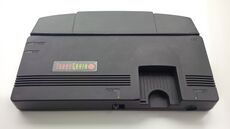Difference between revisions of "TurboGrafx-16/PC Engine"
Jump to navigation
Jump to search
m |
m |
||
| Line 1: | Line 1: | ||
| − | + | {{Infobox_console | |
|image = [[File:TurboGrafX-16_top_front_angle_with_expansion_port_cover.jpg|230px]] | |image = [[File:TurboGrafX-16_top_front_angle_with_expansion_port_cover.jpg|230px]] | ||
|Manufacturer = [[NEC]] | |Manufacturer = [[NEC]] | ||
| Line 7: | Line 7: | ||
1990 (EU) | 1990 (EU) | ||
|Media type = [[HuCard]], CD | |Media type = [[HuCard]], CD | ||
| − | |Successor = [[PC-FX]]|name = [[File:Turbografx-16-logo.png|230px]]}} Following the launch of the PC Engine in Japan, the renamed and re-designed '''TurboGrafX-16 Entertainment Supersystem''' was released in North America on August 29th, 1989 in direct competition with the [[Nintendo Entertainment System]]. | + | |Successor = [[PC-FX]]|name = [[File:Turbografx-16-logo.png|230px]]}} |
| + | Following the launch of the PC Engine in Japan, the renamed and re-designed '''TurboGrafX-16 Entertainment Supersystem''' was released in North America on August 29th, 1989 in direct competition with the [[Nintendo Entertainment System]]. | ||
<h2 style="text-align: left;">Technical specifications</h2> | <h2 style="text-align: left;">Technical specifications</h2> | ||
| − | <p style="text-align: left;">The TurboGrafx-16 has an 8-bit CPU and a dual 16-bit GPU; and is capable of displaying 482 colors simultaneously, out of 512. With dimensions of 14 cm × 14 cm × 3.8 cm (5.5in × 5.5in × 1.5in), the NEC PC Engine holds the record for the world's smallest game console ever made. | + | <p style="text-align: left;">The TurboGrafx-16 has an 8-bit CPU and a dual 16-bit GPU; and is capable of displaying 482 colors simultaneously, out of 512. With dimensions of 14 cm × 14 cm × 3.8 cm (5.5in × 5.5in × 1.5in), the NEC PC Engine holds the record for the world's smallest game console ever made.<br /></p> |
| − | <br/><br/><br/><br/><br/><br/><br/>< | + | |
| − | <gallery position="center" spacing="small" captionposition="within" captionalign="center" orientation="landscape"> | + | <h3 style="text-align: left;">Add-ons</h3> |
| + | |||
| + | *[[Super CD-ROM²]] (PC Engine) | ||
| + | |||
| + | <h3 style="text-align: left;"><br /><br /><br /><br /><br /><br /></h3> | ||
| + | |||
| + | <p style="text-align: left;"><gallery position="center" spacing="small" captionposition="within" captionalign="center" orientation="landscape"> | ||
TurboGrafX-16 TurboPad.jpg | TurboGrafX-16 TurboPad.jpg | ||
TurboGrafX-16 TurboPad underside.jpg | TurboGrafX-16 TurboPad underside.jpg | ||
Revision as of 05:15, 8 June 2013
[[File: |230px]] |230px]]
| |
| Manufacturer | NEC |
|---|---|
| Generation | Fourth generation |
| Release date | October 30, 1987 (JP) August 29, 1989 (NA) |
| Media type | HuCard, CD |
| Successor | PC-FX |
Following the launch of the PC Engine in Japan, the renamed and re-designed TurboGrafX-16 Entertainment Supersystem was released in North America on August 29th, 1989 in direct competition with the Nintendo Entertainment System.
Technical specifications
The TurboGrafx-16 has an 8-bit CPU and a dual 16-bit GPU; and is capable of displaying 482 colors simultaneously, out of 512. With dimensions of 14 cm × 14 cm × 3.8 cm (5.5in × 5.5in × 1.5in), the NEC PC Engine holds the record for the world's smallest game console ever made.
Add-ons
- Super CD-ROM² (PC Engine)











